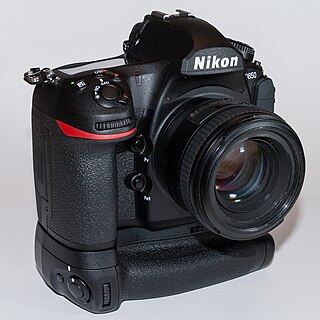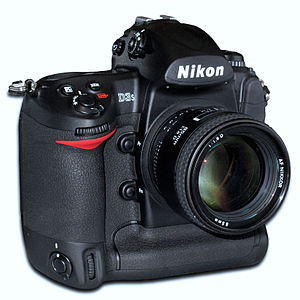
A digital single-lens reflex camera is a digital camera that combines the optics and the mechanisms of a single-lens reflex camera with a digital imaging sensor.

The Nikon D3 is a 12.0-megapixel professional-grade full frame (35 mm) digital single lens reflex camera (DSLR) announced by the Nikon Corporation on 23 August 2007 along with the Nikon D300 DX format camera. It was Nikon's first full-frame DSLR. The D3, along with the Nikon D3X, was a flagship model in Nikon's line of DSLRs, superseding the D2Hs and D2Xs. It was replaced by the D3S as Nikon's flagship DSLR. The D3, D3X, D3S, D4, D4s, D5, D6, D700, D800, D800Е and Df are the only Nikon FX format DSLRs manufactured in Japan. The D3S was replaced by the D4 in 2012.

The Nikon D300 is a 12.3-megapixel semi-professional DX format digital single-lens reflex camera that Nikon Corporation announced on 23 August 2007 along with the Nikon D3 FX format camera. The D300 was discontinued by Nikon on September 11, 2009, being replaced by the modified Nikon D300S, which was released July 30, 2009. The D300S remained the premier Nikon DX camera until the D7100 was released in early 2013.

The Nikon D700 is a professional-grade full-frame digital single-lens reflex camera introduced by the Nikon Corporation in July 2008 and manufactured in Japan. It uses the same 12.1-megapixel "FX" CMOS image sensor as the Nikon D3, and is Nikon's second full-frame digital SLR camera.

The Nikon D90 is a 12.3 megapixel digital single-lens reflex camera (DSLR) model announced by Nikon on August 27, 2008. It is a prosumer model that replaces the Nikon D80, fitting between the company's entry-level and professional DSLR models. It has a Nikon DX format crop sensor.

The Canon EOS 500D is a 15-megapixel entry-level digital single-lens reflex camera, announced by Canon on 25 March 2009. It was released in May 2009. It is known as the EOS Kiss X3 in Japan, and as the EOS Rebel T1i in North America. It continues the Rebel line of mid-range DSLR cameras, is placed by Canon as the next model up from the EOS 450D, and has been superseded by the EOS 550D (T2i).

The D5000 is a 12.3-megapixel DX-format DSLR Nikon F-mount camera, announced by Nikon on 14 April 2009. The D5000 has many features in common with the D90. It features a 2.7-inch 230,000-dot resolution tilt-and-swivel LCD monitor, live view, ISO 200–3200, 3D tracking Multi-CAM1000 11-point AF system, active D-Lighting system and automatic correction of lateral chromatic aberration. The D5000 seems to have been discontinued in November 2010.

The Nikon D300S is a 12.3-megapixel DX format digital single-lens reflex camera (DSLR) announced by Nikon on 30 July 2009. It replaced the D300 as Nikon's flagship DX format DSLR adding HD video recording. It has some similarities to the Nikon D700, with the same resolution, but has a smaller, higher-density sensor. The D300s was superseded by the Nikon D500, announced on January 5, 2016.

The Canon EOS 7D is an APS-C digital single-lens reflex camera made by Canon. It was announced on 1 September 2009 with a suggested retail price of US$1,699. Among its features are an 18.0 effective megapixel CMOS sensor, HD video recording, its 8.0 frames per second continuous shooting, new viewfinder which offers 1.0X magnification and 100% coverage, 19-point auto-focus system, movie mode, and built-in Speedlite transmitter.

The EOS-1D Mark IV is a professional 16.1 effective megapixels digital single lens reflex camera (DSLR) camera body produced by Canon. The EOS-1D Mark IV is the successor of the Canon EOS-1D Mark III and was announced on 20 October 2009, just four days after Nikon announced the D3s. It is currently the only Canon APS-H format DSLR to feature HD video recording at 1080p resolution.

The Nikon D3100 is a 14.2-megapixel DX format DSLR Nikon F-mount camera announced by Nikon on August 19, 2010. It replaced the D3000 as Nikon's entry level DSLR. It introduced Nikon's new EXPEED 2 image processor and was the first Nikon DSLR featuring full high-definition video recording with full-time autofocus and H.264 compression, instead of Motion JPEG compression. It was also the first Nikon DSLR to provide high-definition video recording at more than one frame rate.

The Nikon D7000 is a 16.2-megapixel digital single-lens reflex camera (DSLR) model announced by Nikon on September 15, 2010. It replaced the D90 as the top end consumer camera, but using much of the technology and controls from the earlier D5000, in a larger more robust body similar to the flagship D300 series. In some ways it was superior to the D300S, though for several years the two cameras were both available with the D300 positioned as the flagship in Nikon marketing materials.

The Canon EOS 600D is an 18.0 megapixel digital single-lens reflex camera, released by Canon on 7 February 2011. It is known as the EOS Kiss X5 in Japan and the EOS Rebel T3i in America. The 600D is the second Canon EOS camera with an articulating LCD screen and supersedes the 550D, although the earlier model was not discontinued until June 2012, when the successor of the 600D, the 650D, was announced.

The Nikon D5100 is a 16.2-megapixel DX-format DSLR F-mount camera announced by Nikon on April 5, 2011. It features the same 16.2-megapixel CMOS sensor as the D7000 with 14-bit depth, while delivering Full HD 1080p video mode at either 24, 25 or 30fps. The D5100 is the first Nikon DSLR to offer 1080p video at a choice of frame rates; previous Nikon DSLRs that recorded 1080p only did so at 24 fps. It replaced the D5000 and was replaced by the D5200.

The Nikon D800 is a 36.3-megapixel professional-grade full-frame digital single-lens reflex camera produced by Nikon Corporation. It was given a Gold Award by Digital Photography Review.

The Nikon D4 is a 16.2-megapixel professional-grade full frame (35mm) digital single-lens reflex camera (DSLR) announced by Nikon Corporation on 6 January 2012. It succeeds the Nikon D3S and introduces a number of improvements including a 16.2 megapixel sensor, improved auto-focus and metering sensors and the ability to shoot at an extended ISO speed of 204,800. The camera was released in February 2012 at a recommended retail price of $5999.95. It is the first camera to use the new XQD memory cards. It was replaced by the Nikon D4S as Nikon's flagship camera.

The Nikon D600 is a 24.3-effective-megapixel FX-format full-frame digital SLR camera from Nikon released on September 13, 2012 targeted at professionals and enthusiasts. It began shipping on September 18, 2012; at introduction, its suggested retail price in the U.S. was $2099 for the body only and $2699 with a 24–85 mm kit lens. The Nikon D600 was given a Gold Award by Digital Photography Review.

The Nikon D7100 is a 24.1-megapixel digital single-lens reflex camera model announced by Nikon in February 2013. It is a 'prosumer' model that replaces the Nikon D7000 as Nikon's flagship DX-format camera, fitting between the company's entry-level and professional DSLR models. This camera is the first ever of Nikon, with no optical low-pass filter incorporated. At launch, Nikon gave the D7100 estimated selling price in the United States as US$ 949.95 for the body.

The Nikon D7500 is a 20.9-megapixel digital single-lens reflex camera using an APS-C sensor. It was announced by Nikon Corporation on 12 April 2017, and started shipping on 2 June 2017. It is the successor to the Nikon D7200 as Nikon's DX format midrange DSLR.

The Nikon D850 is a professional-grade full-frame digital single-lens reflex camera (DSLR) produced by Nikon. The camera was officially announced on July 25, 2017, launched on August 24, 2017, and first shipped on September 8, 2017. Nikon announced it could not fill the preorders on August 28, 2017 and filled less than 10% of preorders on the first shipping day. It is the successor to the Nikon D810.





















